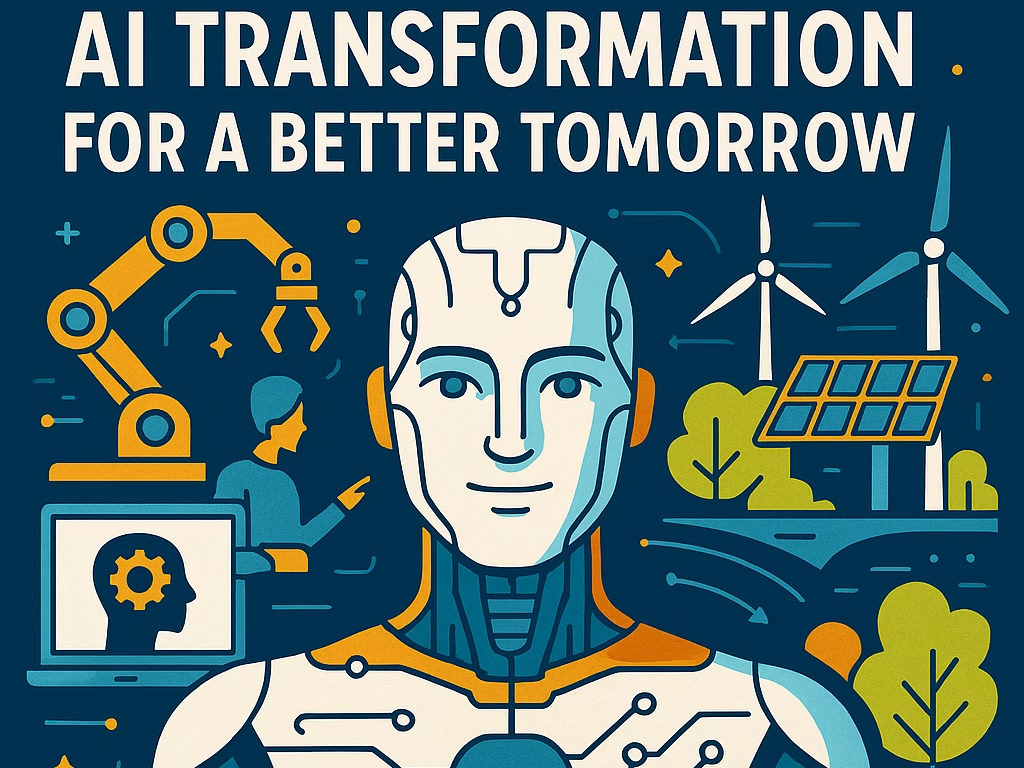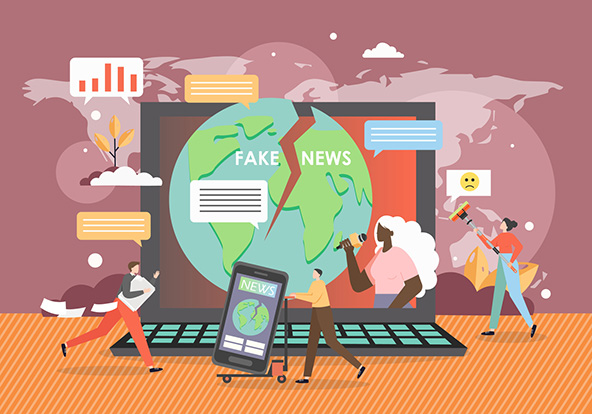
1. Introduction: The Era of AI Transformation
Artificial Intelligence (AI) is no longer a futuristic fantasy; it’s our present reality and a driving force behind the world’s evolution. The AI transformation for a better tomorrow is not just about machines getting smarter; it’s about humanity living better, longer, and more sustainably.
AI spans every corner of modern life, from health to transportation, agriculture, and education. As these intelligent systems learn, adapt, and evolve, they help solve complex global challenges, improving efficiency, saving lives, and preserving the planet.
2. AI in Education
Personalized Learning with Adaptive Systems
One of AI’s most inspiring impacts is in education. AI tailors lessons to suit each student’s needs, offering adaptive learning experiences that adjust difficulty and content in real time. Whether it’s a child struggling with math or a gifted student craving advanced material, AI makes learning more personal and inclusive.
Virtual Tutors and Immersive Experiences
Virtual tutors and AI-driven simulations are revolutionizing classrooms. Students can now explore historical events via VR, solve problems with AI chatbots, or get real-time feedback on essays. Education becomes a 24/7, student-focused journey.
3. AI Revolution in Healthcare
AI Diagnostics and Precision Medicine
AI is helping doctors diagnose diseases with unprecedented speed and accuracy. From analyzing MRI scans to predicting heart conditions, machine learning models are game-changers. They detect patterns the human eye might miss, offering earlier and more precise diagnoses.
Robotic Surgeries and Patient Care Optimization
Robotic-assisted surgeries, guided by AI, ensure better precision and reduced recovery times. AI also personalizes patient care by tracking vitals, reminding patients to take their medicine, and even predicting complications before they arise.
4. Smarter Cities and Sustainable Living
AI-Driven Urban Planning and Traffic Control
AI helps design smarter, safer cities. It manages traffic flow, reduces congestion, and even guides emergency services with predictive analytics. AI isn’t just making cities efficient, it’s making them livable.
Reducing Emissions and Waste Using AI
By analyzing energy use and waste patterns, AI assists governments and businesses in reducing carbon footprints. Smart sensors and automated waste systems help build eco-friendly urban environments.
5. AI and Climate Change Solutions
Predictive Analytics for Environmental Disasters
AI helps predict hurricanes, floods, and wildfires before they strike. These early warnings save lives and minimize damage. It also models climate change scenarios, guiding policymakers toward smarter environmental decisions.
Optimizing Renewable Energy Grids
AI balances electricity loads, stores energy from solar and wind sources, and helps grid operators avoid blackouts. It’s essential for transitioning to sustainable energy systems.
6. AI in Agriculture and Food Security
Smart Farming Through Drones and Sensors
AI-powered drones monitor crop health, detect pests, and improve irrigation. Soil sensors feed data into AI models, enabling farmers to use fewer resources while increasing yields.
Forecasting Crop Yields and Minimizing Waste
AI forecasts crop outputs and manages supply chains to reduce food waste. From farm to fork, it helps ensure everyone has access to nutritious food.
7. Financial Sector Transformation
Fraud Detection and Secure Transactions
AI detects fraud in milliseconds, analyzing patterns in transactions and flagging anomalies. This protects consumers and boosts confidence in digital banking.
AI-Powered Personal Finance Management
AI apps now help users budget, invest, and save smarter. With tailored financial advice and spending insights, people are empowered to build secure futures.
8. AI in Manufacturing and Industry 4.0
Automation and Predictive Maintenance
Machines predict when they’ll break down and alert technicians before failure. This reduces downtime and saves billions in industrial operations.
Optimizing Supply Chains with AI
AI predicts demand, manages inventory, and routes logistics efficiently. It ensures that industries can respond swiftly to global supply chain disruptions.
9. AI in Transportation and Mobility
Autonomous Vehicles and Smart Logistics
Self-driving cars and trucks are no longer science fiction. AI is making roads safer and transport systems more efficient through route optimization and real-time analytics.
Reducing Traffic Accidents with AI Algorithms
AI evaluates road conditions and driver behavior to prevent accidents. Insurance companies even use AI to offer dynamic premiums based on driver safety.
10. Human-AI Collaboration
Augmenting Human Creativity and Productivity
AI doesn’t replace humans, it enhances their potential. Whether it’s brainstorming ideas, coding faster, or designing better, AI is a collaborative partner in progress.
AI as a Partner, Not a Replacement
When humans and AI work together, we unlock greater potential. The key is thoughtful integration, where AI handles routine tasks and humans focus on innovation.
11. Ethical AI and Governance
Ensuring Transparency and Accountability
AI must be explainable. Knowing how a decision was made (e.g., why a loan was denied) is crucial. Ethical AI demands transparency in all its processes.
Bias Detection and Algorithmic Fairness
AI should serve everyone fairly. Developers are training systems to recognize and eliminate bias—so algorithms don’t discriminate based on race, gender, or geography.
12. AI in Security and Surveillance
Intelligent Threat Detection and Prevention
AI monitors networks and detects cyber threats before they cause damage. It also helps law enforcement identify patterns in criminal behavior.
Balancing Security with Privacy
Striking a balance between surveillance and individual rights is critical. Ethical AI ensures monitoring systems are used responsibly.
13. AI and Mental Health Support
Chatbots and Virtual Therapy Platforms
AI-powered mental health tools offer 24/7 support, especially in areas lacking access to professionals. They provide coping strategies, mindfulness, and emergency responses.
Monitoring Mental Well-Being Using AI Tools
Wearables and apps track stress, sleep, and mood, helping users manage their emotional health. AI gives insights that empower self-care and clinical intervention.
14. AI in Art, Music, and Culture
Generating Creative Content with AI
AI creates stunning art, composes symphonies, and writes scripts. It pushes the boundaries of human creativity while inspiring collaboration between tech and talent.
Preserving Heritage Through Digitization
AI helps museums and libraries digitize and restore historical documents, making cultural treasures accessible to all.
15. AI for Social Good
Disaster Relief and Crisis Response
AI analyzes satellite images to assess disaster zones, coordinate rescue missions, and speed up aid delivery. Every second saved can mean a life saved.
Empowering Underserved Communities
AI helps translate languages, improve literacy, and provide access to healthcare—bridging the digital divide and empowering billions.
16. Challenges and Risks of AI Transformation
Job Displacement and Economic Inequality
AI may automate jobs, especially low-skill roles. Reskilling, education, and fair transition policies are vital to avoid widening inequalities.
Cybersecurity Risks and Misuse of AI
AI can be weaponized or misused in scams and surveillance. Robust governance and international cooperation are needed to prevent harm.
17. Conclusion: Building a Responsible AI Future
AI’s potential is limitless, but only if guided ethically and inclusively. Governments, businesses, and citizens must collaborate to shape its trajectory. The AI transformation for a better tomorrow isn’t automatic, it’s a choice we make, together.
Frequently Asked Questions (FAQs)
1. How is AI making the world better?
AI enhances healthcare, education, sustainability, and safety. It solves real-world problems with speed and intelligence.
2. Will AI take away jobs in the future?
Some jobs will be automated, but new roles in AI ethics, data science, and AI management will emerge. Reskilling is key.
3. Is AI dangerous if not controlled?
Yes. Unregulated AI can pose risks like bias, surveillance, or weaponization. Ethical frameworks and laws are essential.
4. How does AI help fight climate change?
AI predicts natural disasters, manages energy grids, and models climate trends, helping create proactive strategies.
5. Can AI be used for good in poor countries?
Absolutely. AI can provide healthcare, language translation, education, and financial tools in underserved areas.
6. What is the most exciting AI development right now?
AI-powered healthcare and climate prediction systems are among the most promising breakthroughs for global well-being.

